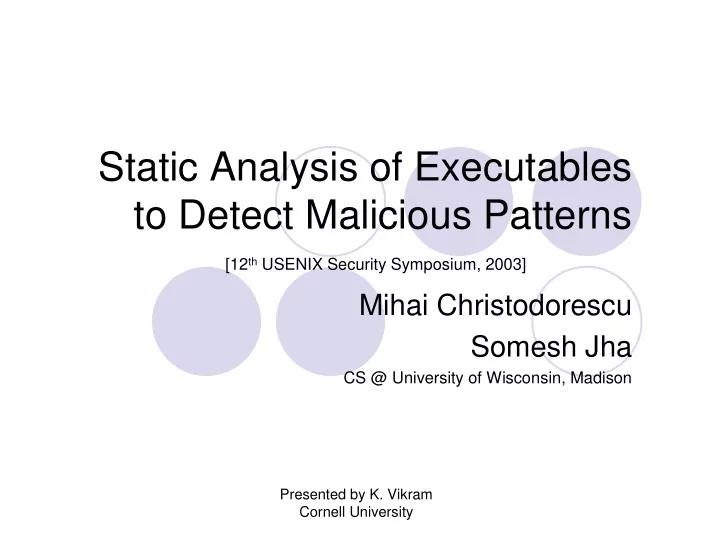

Static Analysis of Executables to Detect Malicious Patterns [12 th USENIX Security Symposium, 2003] Mihai Christodorescu Somesh Jha CS @ University of Wisconsin, Madison Presented by K. Vikram Cornell University
Problem & Motivation… � Malicious code is … malicious � Categorize: Propagation Method & Goal � Viruses, worms, trojan horses, spyware, etc. � Detect Malicious Code � In executables
The Classical Stuff � Focus mostly on Viruses � Code to replicate itself + Malicious payload � Inserted into executables � Look for signatures � Not always enough � Obfuscation-Deobfuscation Game
Common Obfuscation Techniques � Encryption � Dead Code insertion* � Code transposition* � Instruction Substitution* � Register reassignment* � Code Integration � Entry Point Obscuring
Common Deobfuscation Techniques � Regular Expressions � Heuristic Analyses � Emulation Mostly Syntactic…
The Game � Vanilla Virus � Signatures � Register Renaming � Regex Signatures � Packing/Encryption � Emulation/Heuristics � Code Reordering � ? � Code Integration � ?
Current Technology � Antivirus Software � Norton, McAfee, Command � Brittle � Cannot detect simple obfuscations � nop-insertion, code transposition � Chernobyl, z0mbie-6.b, f0sf0r0, Hare
Theoretical Limits � Virus Detection is undecidable � Some Static Analyses are undecidable � But, Obfuscation is also hard
The SAFE* Methodology
Procedure � Key Ideas: � Analyze program’s semantic structure � Use existing static analyses (extensible) � Use uninterpreted symbols � Abstract Representation of Malicious Code � Abstract Representation of Executable � Deobfuscation � Detect presence of malicious code
The Annotator � Inputs: � CFG of the executable � Library of Abstraction Patterns � Outputs: � Annotated CFG
Some groundwork � Instruction I : τ 1 × … × τ k → τ � Program P : � I 1 , …, I N � � Program counter/point � pc : { I 1 , …, I N } → [1,…,N] � pc(I j ) = j, ∀ 1 � j � N � Basic Block, Control Flow Graph* � Static Analysis Predicates � Types for data and instructions
Example Predicates
Abstraction Patterns � Abstraction pattern Γ : (V,O,C) � V = { x 1 : τ 1 , …, x k : τ k } � O = � I(v 1 , …, v m ) | I : τ 1 × … × τ m → τ � � C = boolean expression involving static analysis predicates and logical operators � Represents a deobfuscation � Predicate controls pattern application � Unify patterns with sequence of instructions
Example of a pattern
Defeating Garbage Insertion <instruction A> add ebx, 1 <instruction A> sub ebx, 1 <instruction B> nop <instruction B> instr 1 … Pattern: instr N Where Delta(state pre 1, state post N) = 0
Defeating Code-reordering jmp TARGET Pattern: where Count (CFGPredecessors(TARGET)) = 1
The Annotator � Given set of patterns Σ = { Γ 1 , …, Γ m } � Given a node n for program point p � Matches each pattern in Σ with � …, Previous 2 (I p ), Previous (I p ), I p � � Associates all patterns that match with n � Also stores the bindings from unification
The Detector � Inputs: � Annotated CFG for a procedure � Malicious code representation � Output: � Sequence of instructions exhibiting the malicious pattern
Malicious Code Automaton � Abstraction of the vanilla virus � 6-tuple (V, Σ ,S, δ ,S 0 ,F) � V = { v 1 : τ 1 , …, v k : τ k } � Σ = { Γ 1 , …, Γ n } � S = finite set of states � δ : S × Σ → 2 S is a transition function � S 0 ⊆ S is a non-empty set of initial states � F ⊆ S is a non-empty set of final states
Malicious Code
Detector Operation � Inputs: � CFG P Σ � A = (V, Σ ,S, δ ,S 0 ,F) � Determines whether the same (malicious) pattern occurs both in A and Σ � More formally, tests the emptiness of L(P Σ ) ∩ ( ∪ B ∈ B All L( B ( A )) )
Detector Algorithm � Dataflow-like Algorithm � Maintain a pre and post list at each node of the CFG P Σ � List is of [s, B s ], s is a state in A � Join operation is union
Detector Algorithm � Transfer Function: � Return:
Defenses Against… � Code Re-ordering � Register Renaming � Insertion of irrelevant code � nops*, code that modifies dead registers � Needs live-range and pointer analyses
Experimental Results � False Positive Rate : 0 � False Negative Rate : 0 � not all obfuscations are detected
Performance
Future Directions � New languages � Scripts – VB, JavaScript, ASP � Multi-language malicious code � Attack Diversity � worms, trojans too � Irrelevant sequence detection � Theorem provers � Use TAL/external type annotations
Pitfalls/Criticisms? � Focus on viruses instead of worms � Still fairly Ad-hoc � Treatment of obfuscation is not formal enough � Intractable techniques � Use of theorem provers to find irrelevant code � Slow � No downloadable code � Not enough experimental evaluation
Recommend
More recommend